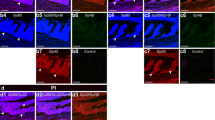Summary
The pituitary gland of Latimeria chalumnae is situated rostroventral to the telencephalon. The hollow pituitary stalk is bent forward and is ventrally connected to a saccus-vasculosus-like organ, rostrally to a neurointermediate lobe. The infundibular lumen protrudes far into the neurohypophysial lobules. The elongated principal part (pars cerebralis) of the pars distalis is partly embedded in a dorsal depression of the pars intermedia and caudally invaded by the neurohypophysis. It may be divided into rostral and proximal pars distalis and includes a ramified hypophysial cleft, which continues rostrally as a duct with adjacent islets of pars distalis tissue (parts of a pars buccalis). The adenohypophysis consists of cell cords and follicles.
Eight tinctorial cell types can be distinguished: in the rostral islets: large basophils with acidophil globules, in the rostral pars distalis: small basophils, large basophils with amphiphil characters and erythrosin-, orange G-positive acidophils; in the proximal pars distalis: orange G-positive acidophils and small and large basophils, having similar staining properties; in the pars intermedia: one amphiphil cell type.
Similar content being viewed by others
References
Adams, C.W.M., Sloper, J.C.: The hypothalamic elaboration of the posterior pituitary principles in man, the rat and dog. Histochemical evidence derived from performic acid-Alcian blue reaction for cystine. J. Endocrinol. 13, 221–228 (1956)
Alluchon-Gérard, M.J.: Types cellulaires et étapes de la différenciation de l'adénohypophyse chez l'embryon de roussette (Scyllium canicula, Chondrichthyens). Étude au microscope électronique. Z. Zellforsch. 120, 525–545 (1971)
Ball, J.N., Baker, B.I.: The pituitary gland: anatomy and histophysiology. In: Fish physiology (Hoar, W.S. and Randall, D.J., eds.), vol. II, p. 207–240. London-New York: Academic Press 1969
Bargmann, W.: Über die neurosekretorische Verknüpfung von Hypothalamus und Neurohypophyse. Z. Zellforsch. 34, 610–634 (1949)
Brookes, L.D.: A stain for differentiating two types of acidophils in the pituitary. Gen. comp. Endocr. 9, 436 (1967)
Doerr-Schott, J.: Cyto-immunochemical study of the hypophysial cells of amphibians by light- and electron-microscopy. Fortschr. Zool. 22, 245–267 (1974)
Ezrin, C., Murray, S.: The cells of the human adenohypophysis in pregnancy, thyroid disease and adrenal cortical disorders. In: Cytologie de l'adénohypophyse, ed. by J. Benoit and Chr. Da Lage. Colloq. int. Centr. nat. Rech. Sci. 128, 183–200 (1963)
Gabe, M.: Sur quelques applications de la coloration par la fuchsine-paraldéhyde. Bull. Microsc. appl. 3, 153–162 (1953)
Halmi, N.S.: Differentiation of two types of basophils in the adenohypophysis of the rat and the mouse. Stain Technol. 27, 61–64 (1952)
Herlant, M.: Corrélations hypophyse-génitales chez la femelle de la chauve-souris, Myotis myotis (Borkhausen). Arch. Biol. Liège 67, 89–180 (1956)
Herlant, M.: Étude critique de deux techniques nouvelles destinées à mettre en évidence les différentes catégories cellulaires présentes dans la glande pituitaire. Bull. Microsc. appl. 10, 37–44 (1960)
Holmes, R.L., Ball, J.N.: The pituitary gland, a comparative account. Cambridge: University Press 1974
Kemenade, J.A.M. van: The effects of metopirone and aldactone on the pars distalis of the pituitary, the interrenal tissue and the interstitial tissue of the testis in the common frog, Rana temporaria. Z. Zellforsch. 96, 466–477 (1969)
Kemenade, J.A.M. van: Regulation of the interrenal gland and demonstration of cell types in the pars distalis of Amphibia. Fortschr. Zool. 22, 228–244 (1974)
Kerr, T., Oordt, P.G.W.J. van: The pituitary of the African lungfish Protopterus sp. Gen. comp. Endocr. 7, 549–558 (1966)
Kremers, J.W.: The central nervous system of the crossopterygian Latimeria chalumnae. Thesis in preparation 1976
Lagios, M.D.: The median eminence of the bowfin, Amia calva L. Gen. comp. Endocr. 15, 453–463 (1970)
Lagios, M.D.: Evidence for a hypothalamo-hypophysial portal vascular system in the coelacanth Latimeria chalumnae Smith. Gen. comp. Endocr. 18, 73–82 (1972)
McConaill, M.A.: The staining of the central nervous system with lead-haematoxylin. J. Anat. (Lond.) 81, 371–372 (1947)
Mellinger, J.: Développement post-embryonnaire de l'adénohypophyse de la torpille (Torpedo marmorata, Chondrichthyens); évolution du système des cavités et manifestations du dimorphisme sexuel. Ann. Univ. et A.R.E.R.S. 7, 33–48 (1969)
Millot, J., Anthony, J.: Considérations physiomorphologiques sur la tête de Latimeria (Crossoptérygien Coelacanthidé). C.R. Acad. Sci. (Paris) 241, 114–116 (1955)
Millot, J., Anthony, J.: Crossoptérygiens actuels. In: Traité de zoologie (Grassé, P.P., ed.), vol. XIII/3, p. 2553–2597. Paris: Masson 1958
Millot, J., Anthony, J.: Anatomie de Latimeria chalumnae. In: Système nerveux et organes des sens, vol. II. Paris: Centr. nat. Rech. sci. 1965
Millot, J., Nieuwenhuys, R., Anthony, J.: Le diencéphale de Latimeria chalumnae Smith (poisson coelacanthidé). C.R. Acad. Sci. (Paris) 258, 5051–5055 (1964)
Nieuwenhuys, R.: The forebrain of the crossopterygian Latimeria chalumnae Smith. J. Morphology 117, 1–24 (1965)
Oordt, P.G.W.J. van: The analysis and identification of the hormone-producing cells of the adenohypophysis. In: Perspectives in endocrinology (Barrington, E. J. W. and Jørgensen, C.B., eds.), p. 405–467. London and New York: Academic Press 1968
Oordt, P.G.W.J. van: Cytology of the adenohypophysis. In: Physiology of the Amphibia (Lofts, B., ed.), vol. II, p. 53–106. London and New York: Academic Press 1974
Racadot, J.: Sur la mise en évidence des types cellulaires adénohypophysaires par la méthode de Herlant au blue d'alizarine acide. Bull. Microsc. appl. 12, 16–20 (1962)
Wingstrand, K.G.: Comparative anatomy and evolution of the hypophysis. In: The pituitary gland (Harris, G.W. and Donovan, B.T., eds.), vol. I, p. 58–126. London: Butterworths 1966
Zambrano, D., Iturriza, F.C.: Hypothalamo-hypophysial relationships in the South American lungfish, Lepidosiren paradoxa. Gen. comp. Endocr. 20, 256–273 (1973)
Author information
Authors and Affiliations
Additional information
It is a pleasure to acknowledge Prof. Dr. J. Anthony, Laboratoire d'Anatomie comparée, Paris, who provided us with the pituitary material. We wish to thank Prof. Dr. A.P. van Overbeeke for a critical reading of the manuscript. Thanks are also due to Mrs. Caria de Vocht-Poort, Miss Ans Rouwenhorst, and Mr. G. Spaan for their conscientious technical assistance, to Mr. M. Willems for printing the photographs, and to Mr. Chr. van Huyzen for his contribution to the realization of the graphic reconstructions.
Rights and permissions
About this article
Cite this article
van Kemenade, J.A.M., Kremers, J.W. The pituitary gland of the coelacanth fish Latimeria chalumnae Smith: General structure and adenohypophysial cell types. Cell Tissue Res. 163, 291–311 (1975). https://doi.org/10.1007/BF00219465
Received:
Issue Date:
DOI: https://doi.org/10.1007/BF00219465




